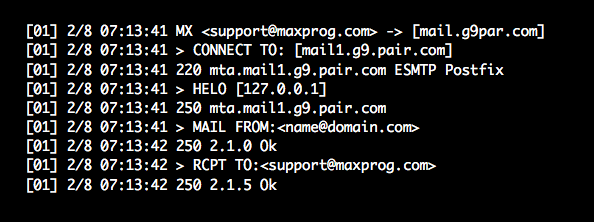Port 25 blocking fully prevents email validation to be possible! eMail Verifier requires full access to port 25 in order to work.
Don’t even waste your time trying with other “alternative” ports, it doesn’t work!
eMail Verifier is not an email client, it never connects to your mail server.
eMail Verifier actually connects to other’s mail servers through the port 25.
Why this?
Port 25 blocking effects
Port 25 is just a network connection channel. Some Internet Service Providers (ISP) intercept port 25 so it is not possible to use eMail Verifier nor any software using port 25.
Some independent SMTP servers support an additional port other than 25 (26, 587, 2525…) to allow users with authenticated access to connect to them even if port 25 is blocked.
Unfortunately, eMail Verifier can’t use such an alternative port as it needs to connect to each address SMTP relay server, not only your server.Relay servers (MTA) only work on port 25.
In fact, all e-mail sent via the Internet is routed through port 25.
When you run eMail Verifier on your computer, it always uses port 25 to connect to remote e-mail relay servers.
Therefore, if your ISP is blocking the port, eMail Verifier will be unable to fully test e-mail addresses.
eMail Verifier can check the syntax of the e-mail addresses and whether the domain they belong to exists. However, the last step will fail. eMail Verifier will not be able to connect to the address MX Exchanger server.
Why port 25 can be blocked
A few ISPs are blocking port 25. They are doing this to cut down on the amount of spam that is sent from their networks.
All e-mail sent via the Internet is routed through the port 25, the channel used for communication between an e-mail client and an e-mail server.
Port 25 blocking allows ISPs to block spam sent out through their networks, but it tends to punish the innocent that have a need to use tools like eMail Verifier or to send through e-mail servers other than those belonging to their ISP.
The ISPs that block port 25 require their SMTP server to be used instead of the remote SMTP server or an SMTP server running on your computer.
Unfortunately, there is nothing we can do to change this. Port 25 is the standard for sending messages and the one eMail Verifier uses.
The only solutions are either to contact your ISP and see if they can remove that block or switch to another ISP. Smaller local ISP’s usually do not block Port 25.
How to find out whether port 25 is blocked by your ISP?
You can easily check whether you are affected by port blocking by using eMail Verifier itself, just verify a single address, an address from anyone but you, I mean, do no use any of your own addresses.
Then go to the eMail Verifier console panel and look at the text returned by the server:
– If your internet provider doesn’t block port 25, you will get a successful response with code ‘220’ like this:

– If your internet provider blocks port 25, you will get several connection retries followed by a timeout:

